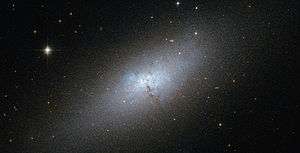NGC 5253
| NGC 5253 | |
|---|---|
|
NGC 5253 is one of the nearest of the known Blue Compact Dwarf (BCD) galaxies[1] | |
| Observation data | |
| Constellation | Centaurus |
| Right ascension | 13h 39m 55.9s[2] |
| Declination | −31° 38′ 24″[2] |
| Redshift | 407 ± 3 km/s[2] |
| Distance | 10.9 ± 0.6 Mly (3.33 ± 0.17 Mpc)[3] |
| Apparent magnitude (V) | 10.9[2] |
| Characteristics | |
| Type | Im pec[2] |
| Apparent size (V) | 5′.0 × 1′.9[2] |
| Other designations | |
| UGCA 369,[2] PGC 48334,[2] Haro 10[2] | |
NGC 5253 is an irregular galaxy in the constellation Centaurus. It was discovered by John Frederick William Herschel on 15 March 1787.[4]
Properties
NGC 5253 is located within the M83 Subgroup of the Centaurus A/M83 Group, a relatively nearby galaxy group that includes the radio galaxy Centaurus A and the spiral galaxy M83 (the Southern Pinwheel Galaxy).
NGC 5253 is considered a dwarf starburst galaxy[5] and also a blue compact galaxy.[6] Supernova 1972E, the second-brightest recent supernova visible from Earth (peak visual magnitude of 8.5, fainter only than SN 1987A in the 20th century), occurred in this galaxy.[7][8] Another supernova, SN 1895b, also has been recorded in the galaxy.[9]
Contents
NGC 5352 contains a giant dust cloud, hiding a cluster of more than one million stars, among them up to 7,000 O stars. The super star cluster is 3 million years old and has a total luminosity of more than one billion suns. The amount of dust surrounding the stars is extraordinary — approximately 15,000 times the mass of our sun in elements such as carbon and oxygen. The dust cloud, called Cloud D is also very efficient in creating new stars. How much of a gas cloud gets turned into stars varies in different parts of the universe. In the Milky Way, the rate for gas clouds the size of Cloud D is less than 5 percent. In Cloud D, the rate is at least 10 times higher, and perhaps much more. In coming years, the cloud could be destroyed by stars that become supernovae, which would spin all of the gas and elements created by the stars into interstellar space.[10][11]
References
- ↑ "A Peculiar Compact Blue Dwarf Galaxy". ESA/Hubble Picture of the Week. Retrieved 26 November 2012.
- 1 2 3 4 5 6 7 8 9 "NASA/IPAC Extragalactic Database". Results for NGC 5253. Retrieved 2006-11-10.
- ↑ Ferrarese, Laura; Ford, Holland C.; Huchra, John; Kennicutt, Robert C., Jr.; et al. (2000). "A Database of Cepheid Distance Moduli and Tip of the Red Giant Branch, Globular Cluster Luminosity Function, Planetary Nebula Luminosity Function, and Surface Brightness Fluctuation Data Useful for Distance Determinations". The Astrophysical Journal Supplement Series. 128 (2): 431–459. arXiv:astro-ph/9910501
 . Bibcode:2000ApJS..128..431F. doi:10.1086/313391.
. Bibcode:2000ApJS..128..431F. doi:10.1086/313391. - ↑ The scientific papers of Sir William Herschel by J. L. E. Dreyer. Royal Astronomical Society London 1912.
- ↑ Jordan Zastrow; M.S. Oey; Sylvain Veilleux; Michael McDonald; Crystal L. Martin (2011). "An Ionization Cone in the Dwarf Starburst Galaxy NGC 5253". arXiv:1109.6360
 .
. - ↑ "Hubble Spots a Peculiar Compact Blue Dwarf Galaxy". NASA. 30 November 2012. Archived from the original on 11 September 2014.
- ↑ I. D. Karachentsev; M. E. Sharina; A. E. Dolphin; E. K. Grebel; et al. (2002). "New distances to galaxies in the Centaurus A group". Astronomy and Astrophysics. 385 (1): 21–31. Bibcode:2002A&A...385...21K. doi:10.1051/0004-6361:20020042.
- ↑ I. D. Karachentsev (2005). "The Local Group and Other Neighboring Galaxy Groups". Astronomical Journal. 129 (1): 178–188. arXiv:astro-ph/0410065
 . Bibcode:2005AJ....129..178K. doi:10.1086/426368.
. Bibcode:2005AJ....129..178K. doi:10.1086/426368. - ↑ Kowal, C. T.; Sargent, W. L. W. (Nov 1971). "Supernovae discovered since 1885". Astronomical Journal. 76: 756–764. Bibcode:1971AJ.....76..756K. doi:10.1086/111193.
- ↑ Stuart Wolpert (March 18, 2015). "More than a million stars are forming in a mysterious dusty gas cloud in a nearby galaxy" (Press release). UCLA. Archived from the original on March 19, 2015.
- ↑ J. L. Turner; S. C. Beck; D. J. Benford; S. M. Consiglio; et al. (2015). "Highly efficient star formation in NGC 5253 possibly from stream-fed accretion.". Nature. 519: 331–333. arXiv:1503.05254
 . doi:10.1038/nature14218.
. doi:10.1038/nature14218.

